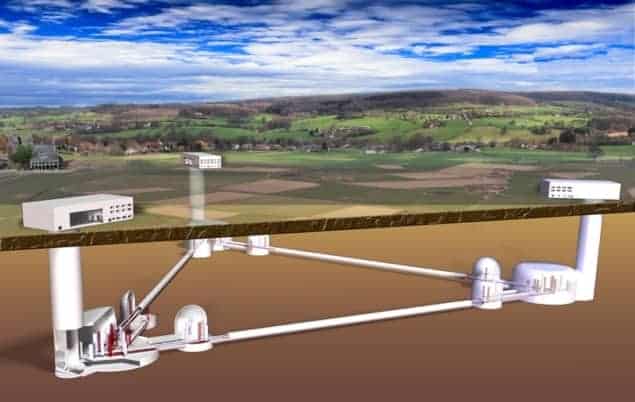
Researchers have drawn up plans for the next-generation gravitational-wave observatory that will be 100 times more sensitive than current instruments. The Einstein Telescope, which is estimated to cost around €790m and be complete by 2025, will seek to directly detect gravitational waves and attempt to work out their origin and nature. It will differ from existing gravitational-wave detectors in being built underground.
Researchers will now begin carrying out a detailed technical design for the Einstein Telescope, which is expected to be complete by 2017, as well as selecting its location. The telescope is one of seven projects recommended by the Astroparticle European Research Area (ASPERA) network, funded by the European Commission, the CERN particle-physics lab and 17 countries including Germany, Russia and the UK.
Gravitational waves are ripples in the fabric of space–time that Einstein’s general theory of relativity predicts ought to pervade the universe. The Einstein Telescope – known as a third-generation gravitational-wave observatory – would be similar in design to existing labs such as the US-based LIGO gravitational-wave observatory in Hanford, Washington, and Livingston, Louisiana.
LIGO works by having two 4 km long interferometers at 90° to each other in which a laser beam is split and sent down each arm. The beams then bounce off test masses at the end of each arm and return to their starting point, where they interfere with one another. Any passing gravitational wave will make one arm slightly longer and the other slightly shorter, thereby changing the interference pattern in a measurable way.
Going underground
The Einstein Telescope will study the entire range of gravitational-wave frequencies – from 1 Hz to 10 kHz – from astronomical sources that can be measured on Earth. The observatory will be built underground at a depth of about 100–200 m and will consist of three underground detectors, each linked by two 10 km long interferometer arms.
One of the interferometers will detect low-frequency gravitational-wave signals from 2 to 40 Hz, while the other will detect the higher-frequency signals. “The fact that the Einstein Telescope will be underground allows us to extend the sensitive window down to lower frequencies, such as those below 10 Hz,” says Andreas Freise from the University of Birmingham in the UK, who leads the optical design of the telescope. “Many gravitational-wave signals from, for example, black holes crashing into each other, will have a significant signature in that range.”
LIGO is currently being upgraded to Advanced LIGO, which will make it 10 times more sensitive. According to Freise, physicists expect Advanced LIGO to make the first direct detection of gravitational waves, but as the Einstein Telescope will be a further 10 times more sensitive, it will be better placed to estimate the origins of gravitational waves and give information about the local gravitational environment around them.



